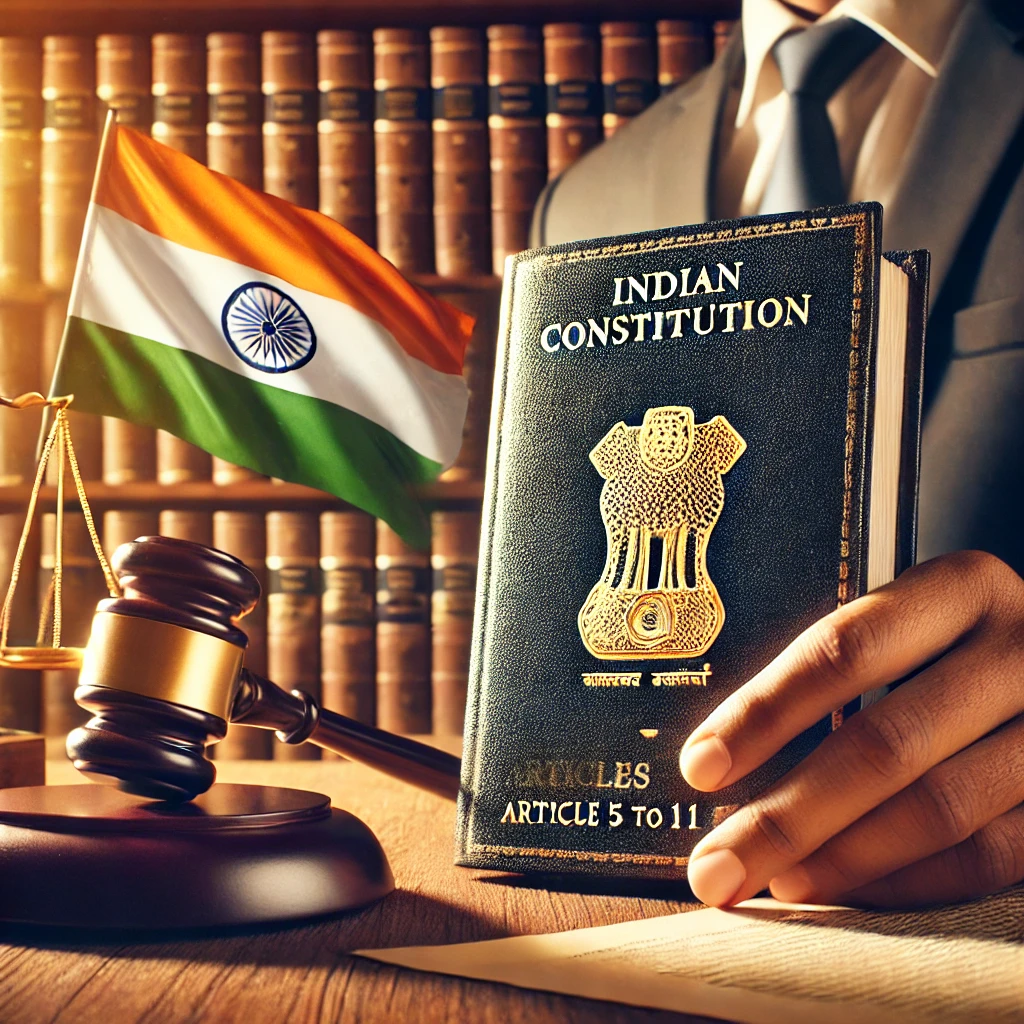The Constitution of India, adopted in 1950, lays down provisions related to citizenship in Part II, which comprises Articles 5 to 11. These articles define who is considered a citizen of India at the commencement of the Constitution and empower the Parliament to regulate future aspects of citizenship. Let’s examine each of these articles in detail.
Introduction to Citizenship in India
Citizenship determines the relationship between an individual and the state, entitling citizens to certain rights, privileges, and responsibilities. The Indian Constitution, under Part II, initially provided provisions for citizenship at the time of independence. However, since independence, the Parliament has enacted several laws to govern citizenship, most notably the Citizenship Act of 1955, which has been amended several times.
Article 5: Citizenship at the Commencement of the Constitution
Article 5 specifies who shall be considered a citizen of India as of January 26, 1950, the day the Constitution came into effect. It states that:
- A person who had his domicile in the territory of India and
- Who was either born in India, or
- Either of whose parents were born in India, or
- Who had been ordinarily residing in India for at least five years before January 26, 1950,
would be considered a citizen of India.
This article ensured that individuals who had been residing in India for a significant period, regardless of their place of birth, were granted citizenship. It recognized the importance of domicile, meaning a person must have a permanent home in India to qualify.
Article 6: Rights of Citizenship of Certain Persons Who Have Migrated from Pakistan
India was partitioned in 1947, leading to large-scale migration between India and Pakistan. Article 6 provides citizenship rights to those who migrated from Pakistan to India before the commencement of the Constitution.
This article distinguishes two categories of migrants:
- Migrants who arrived before July 19, 1948:
- If a person migrated to India before July 19, 1948, and had resided in India since migration, he or she would be deemed a citizen of India.
- If a person migrated to India before July 19, 1948, and had resided in India since migration, he or she would be deemed a citizen of India.
- Migrants who arrived after July 19, 1948:
- A person who migrated after this date had to register as a citizen with the Indian government. They had to prove that they had been residing in India for at least six months before applying for registration.
The rationale behind this distinction was to regulate the large influx of migrants post-partition and prevent security concerns.
Article 7: Citizenship Rights of Certain Migrants to Pakistan
Article 7 deals with individuals who migrated to Pakistan but later decided to return to India. It states that:
- A person who had migrated to Pakistan after March 1, 1947, but later returned to India with a resettlement permit issued by the government would be eligible for Indian citizenship.
This provision aimed to accommodate those who left for Pakistan but later realized they wanted to return and settle permanently in India. However, the condition of obtaining a permit was imposed to regulate the process.
Article 8: Citizenship Rights of Persons of Indian Origin Residing Outside India
Article 8 provides provisions for Indians who were living outside India at the commencement of the Constitution. It states:
- A person who was of Indian origin and was residing in another country but wished to be a citizen of India could apply for citizenship at an Indian consulate.
- The individual had to prove that either they or their parents or grandparents were born in India.
This provision was especially significant for the Indian diaspora living abroad, ensuring they had a legal route to claim Indian citizenship if they desired.
Article 9: No Dual Citizenship
Article 9 establishes a critical principle in Indian citizenship law—India does not recognize dual citizenship. It states:
- If an Indian citizen voluntarily acquires the citizenship of another country, they cease to be an Indian citizen.
This means that once an individual takes up citizenship in another country, they automatically forfeit their Indian citizenship. This provision was included to maintain the sovereignty and integrity of Indian nationality.
Article 10: Continuance of Citizenship Rights
Article 10 ensures the continuity of citizenship rights for those recognized as citizens under Articles 5 to 9. It states:
- Any person deemed a citizen of India under the provisions of the Constitution shall continue to be a citizen, subject to any laws made by Parliament regarding citizenship.
This article gives Parliament the power to regulate and make laws related to citizenship, ensuring that the rights of citizens are subject to future legislative changes.
Article 11: Power of Parliament to Regulate Citizenship
Article 11 grants extensive powers to the Indian Parliament to make laws regarding citizenship. It states:
- Parliament has the authority to make laws relating to the acquisition, termination, and other matters concerning citizenship.
This article enabled the enactment of the Citizenship Act of 1955, which has undergone multiple amendments to address changing requirements.
Citizenship Act of 1955: An Extension of Articles 5 to 11
The Citizenship Act, 1955, was enacted by Parliament to regulate various aspects of citizenship. It provides different ways to acquire Indian citizenship:
- By Birth:
- A person born in India on or after January 26, 1950, but before July 1, 1987, is an Indian citizen.
- A person born between July 1, 1987, and December 3, 2004, is an Indian citizen if one parent is an Indian citizen at the time of birth.
- A person born after December 3, 2004, is a citizen only if both parents are Indian citizens, or if one parent is an Indian citizen and the other is not an illegal immigrant.
- A person born in India on or after January 26, 1950, but before July 1, 1987, is an Indian citizen.
- By Descent:
- A person born outside India is considered an Indian citizen if at least one parent is an Indian citizen at the time of birth.
- A person born outside India is considered an Indian citizen if at least one parent is an Indian citizen at the time of birth.
- By Registration:
- Certain categories of people, such as persons of Indian origin residing in India for at least seven years, can apply for citizenship.
- Certain categories of people, such as persons of Indian origin residing in India for at least seven years, can apply for citizenship.
- By Naturalization:
- Foreigners residing in India for at least 12 years and meeting other qualifications can acquire citizenship through naturalization.
- Foreigners residing in India for at least 12 years and meeting other qualifications can acquire citizenship through naturalization.
- By Incorporation of Territory:
- If a new territory becomes part of India, its residents automatically become Indian citizens.
Amendments to the Citizenship Act
Several amendments have been made to the Citizenship Act, including:
- The Citizenship (Amendment) Act, 1986: Made the conditions of citizenship by birth stricter.
- The Citizenship (Amendment) Act, 2003: Introduced the concept of Overseas Citizens of India (OCI).
- The Citizenship (Amendment) Act, 2019: Provided a special provision for persecuted minorities (Hindus, Sikhs, Buddhists, Jains, Parsis, and Christians) from Pakistan, Bangladesh, and Afghanistan to acquire Indian citizenship under certain conditions.
Conclusion
Articles 5 to 11 of the Indian Constitution laid the foundation for determining Indian citizenship at the time of independence. These provisions, supplemented by the Citizenship Act of 1955 and its amendments, have shaped India’s citizenship laws over the years. While Article 5 defined citizenship at the commencement of the Constitution, Articles 6, 7, and 8 addressed the complex migration issues due to partition. Articles 9, 10, and 11 ensured that Indian citizenship remained a well-regulated legal status. The power of Parliament to make laws regarding citizenship has allowed India to adapt its policies to changing national and international scenarios, maintaining the integrity and security of its citizenship framework.




